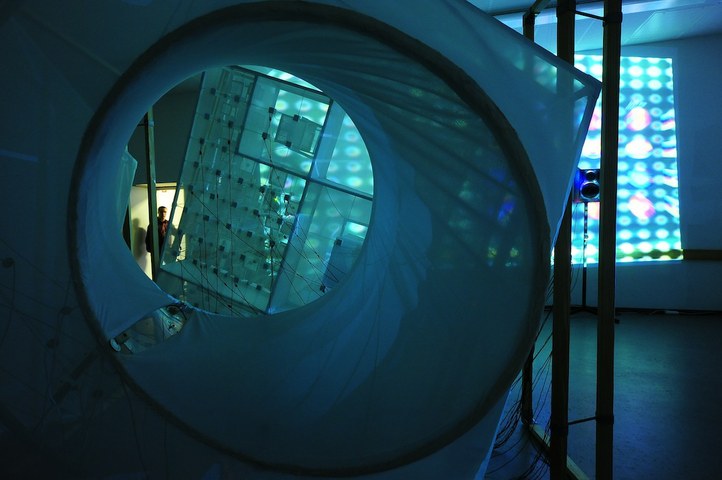Sensory neuronal networks – Art exhibition at the Bernstein Center Freiburg
The installation "Sensory neuronal networks" was presented to the public for the first time at the Bernstein Conference 2011 in Freiburg.
“The intention of this project is to offer a perspective on neuronal interactions that is accessible in the strictest sense of the word, establishing a connection with the neurobiological ‘inner world’ through computer simulations that are based on the insights of neuroscientific research. For now, our installation is only able to stimulate such a perspective, but not to found a scientific method.”
(Rainer Dunkel)
Reducing complex questions to their basics is the essence of scientific and artistic work alike. One characteristic difference between these disciplines lies in the criteria that are being applied to identify the aforementioned ‘basics’. Whereas the natural sciences strive to establish maximally transparent and objective quality criteria, e.g., through the peer-review process, the contemporary artistic exploration aims mainly at the subjective experience of the recipient. Considering these fundamental differences, it is not astonishing that these two disciplines hardly benefit from each other nowadays, irrespective of their comparable goals.
With their installation sensory neuronal networks, Berlin-based artist Rainer Dunkel and the Bernstein Center Freiburg, particularly Benjamin Staude as well as Stefan Rotter, Arvind Kumar, and Gunnar Grah, endeavor to initiate a discourse that is productive for both disciplines. At the core of their work lies a neuronal, conductance-based integrate-and-fire network. On the one hand, this network controls the acoustic-visual presence of the installation: The tonal translations of firing neurons within the network create an acoustic representation of the neuronal dynamics. On the other hand, sensory elements at the installation allow to directly influence the controlling network. Thus, the immense complexity of neuronal dynamics becomes immediately accessible to the recipient, allowing to directly experience some perpetual questions of neuroscience: How can a system be so reliable in its performance if it reacts in such different ways to apparently identical stimuli? What are the similarities in its responses to identical, as opposed to differing stimuli…?
Approaching a topic of research from an aesthetic perspective furthermore allows a scientist to pose a novel set of questions, for instance: Which aspects of neuronal dynamics are lost through their description in an objectifying, statistic description? How are acoustically perceptible melodies reflected statistically within a network’s activity? Are such aesthetic components biologically relevant – and if they are, could these effects be measured?
The juxtaposition of scientifically-abstract thought and physically-sensual experience in an artistic form offers the chance to confront the scientists themselves in new ways with aspects of their own work. Consequently, the space of the installation becomes “neutral ground” on which scientists and members of the public face the function of their brains as equals. Fostered by the unusual form and an experience that is new for both groups, the installation enables them to enter a dialog.



